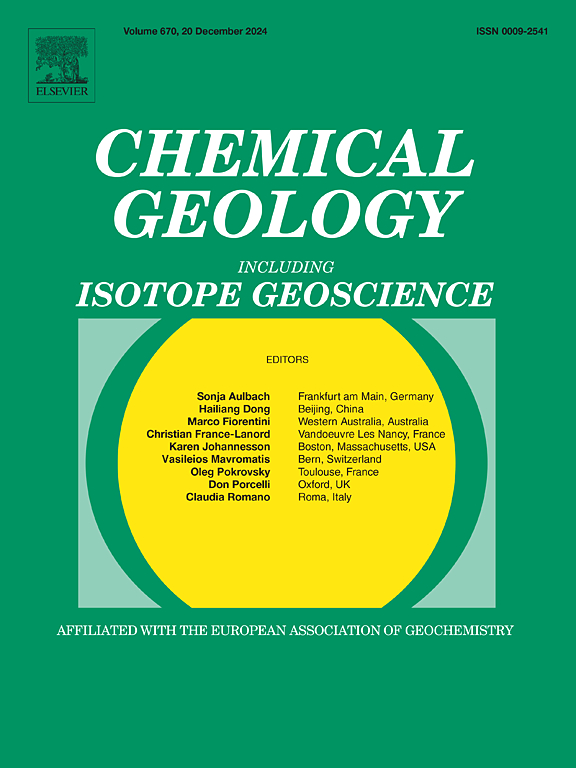Vapor-liquid and liquid-liquid phase equilibria in the CO2-CH4-N2 system: A Gibbs ensemble Monte Carlo simulation
IF 3.6
2区 地球科学
Q1 GEOCHEMISTRY & GEOPHYSICS
引用次数: 0
Abstract
CO2, CH4, and N2 are the most common gaseous species in geological fluids, originating from diverse sedimentary, metamorphic, igneous, and hydrothermal processes. Analyzing relic paleo-geofluids trapped in minerals as fluid inclusions is crucial for understanding their roles in these geological processes, which depends on the established phase and volumetric behavior of the fluids as a function of pressure (P), temperature (T), and composition (x). However, collecting comprehensive data for such a ternary system across all potential PTx variables is a significant experimental challenge. Therefore, this study simulated the fluid-phase equilibrium in the unary, binary, and ternary systems of CO2-CH4-N2 using the Gibbs Ensemble Monte Carlo (GEMC) method, a powerful molecular simulation technique for studying systems with multiple fluid phases. The considered PT range encompasses liquid/liquid, liquid/vapor, and liquid/liquid/vapor equilibrium regions. Molecular interactions in the system are described using two-body Lennard-Jones potentials, requiring only two temperature-independent parameters for similar molecules. The Berthelot-Lorentz rules are applied to define the Lennard-Jones interactions for dissimilar molecules, with an additional temperature-independent mixing parameter. The equilibrium compositions and molar volumes of the coexisting phases in all mixtures are predicted with an accuracy comparable to that of the experimental data. The PT dependence of liquid-liquid-vapor coexistence at very low temperatures and the potential for gas-gas coexistence at high temperatures are discussed for the binary subsystems. It can be concluded that the GEMC simulation is an important “computational experiment” to investigate thermodynamic properties of natural fluids if molecular interaction potential is well described, providing appreciable supplementation to experimental findings.
CO2-CH4-N2体系的气液和液液相平衡:Gibbs系综蒙特卡罗模拟
CO2、CH4和N2是地质流体中最常见的气体种类,它们起源于不同的沉积、变质、火成岩和热液作用。分析作为包裹体被困在矿物中的古地球流体对于理解它们在这些地质过程中的作用至关重要,这取决于流体作为压力(P)、温度(T)和成分(x)的函数的既定相和体积行为。然而,在所有可能的PTx变量中收集这样一个三元系统的综合数据是一个重大的实验挑战。因此,本研究采用Gibbs Ensemble Monte Carlo (GEMC)方法模拟了CO2-CH4-N2一、二、三元体系的液相平衡,这是一种研究多流体相体系的强大分子模拟技术。所考虑的PT范围包括液/液、液/汽和液/液/汽平衡区域。系统中的分子相互作用是用两体伦纳德-琼斯势来描述的,对于类似的分子只需要两个温度无关的参数。贝特洛特-洛伦兹规则用于定义不同分子的伦纳德-琼斯相互作用,并附加了一个与温度无关的混合参数。所有混合物中共存相的平衡组成和摩尔体积的预测精度与实验数据相当。讨论了极低温下液-液-气共存的PT依赖性和高温下气-气共存的可能性。可以得出结论,如果分子相互作用势得到很好的描述,GEMC模拟是研究自然流体热力学性质的重要“计算实验”,对实验结果提供了可观的补充。
本文章由计算机程序翻译,如有差异,请以英文原文为准。
求助全文
约1分钟内获得全文
求助全文
来源期刊

Chemical Geology
地学-地球化学与地球物理
CiteScore
7.20
自引率
10.30%
发文量
374
审稿时长
3.6 months
期刊介绍:
Chemical Geology is an international journal that publishes original research papers on isotopic and elemental geochemistry, geochronology and cosmochemistry.
The Journal focuses on chemical processes in igneous, metamorphic, and sedimentary petrology, low- and high-temperature aqueous solutions, biogeochemistry, the environment and cosmochemistry.
Papers that are field, experimentally, or computationally based are appropriate if they are of broad international interest. The Journal generally does not publish papers that are primarily of regional or local interest, or which are primarily focused on remediation and applied geochemistry.
The Journal also welcomes innovative papers dealing with significant analytical advances that are of wide interest in the community and extend significantly beyond the scope of what would be included in the methods section of a standard research paper.
 求助内容:
求助内容: 应助结果提醒方式:
应助结果提醒方式:


